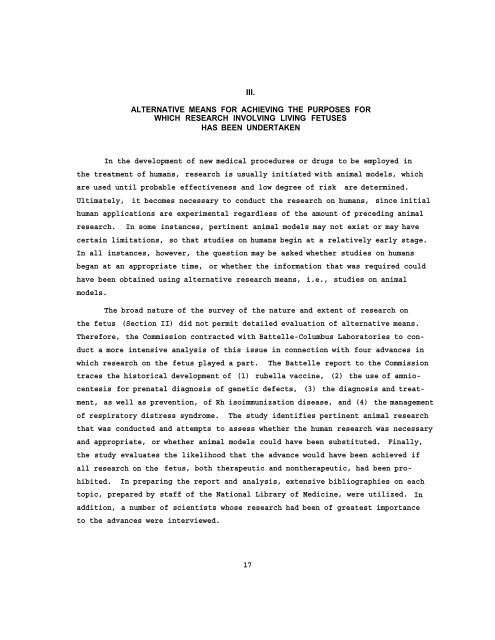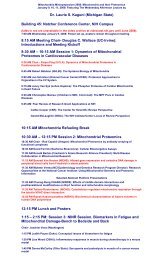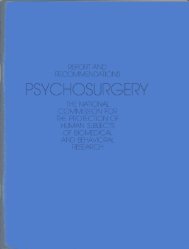RESEARCH ON THE FETUS - National Institutes of Health
RESEARCH ON THE FETUS - National Institutes of Health
RESEARCH ON THE FETUS - National Institutes of Health
You also want an ePaper? Increase the reach of your titles
YUMPU automatically turns print PDFs into web optimized ePapers that Google loves.
III.<br />
ALTERNATIVE MEANS FOR ACHIEVING <strong>THE</strong> PURPOSES FOR<br />
WHICH <strong>RESEARCH</strong> INVOLVING LIVING <strong>FETUS</strong>ES<br />
HAS BEEN UNDERTAKEN<br />
In the development <strong>of</strong> new medical procedures or drugs to be employed in<br />
the treatment <strong>of</strong> humans, research is usually initiated with animal models, which<br />
are used until probable effectiveness and low degree <strong>of</strong> risk are determined.<br />
Ultimately, it becomes necessary to conduct the research on humans, since initial<br />
human applications are experimental regardless <strong>of</strong> the amount <strong>of</strong> preceding animal<br />
research. In some instances, pertinent animal models may not exist or may have<br />
certain limitations, so that studies on humans begin at a relatively early stage.<br />
In all instances, however, the question may be asked whether studies on humans<br />
began at an appropriate time, or whether the information that was required could<br />
have been obtained using alternative research means, i.e., studies on animal<br />
models.<br />
The broad nature <strong>of</strong> the survey <strong>of</strong> the nature and extent <strong>of</strong> research on<br />
the fetus (Section II) did not permit detailed evaluation <strong>of</strong> alternative means.<br />
Therefore, the Commission contracted with Battelle-Columbus Laboratories to conduct<br />
a more intensive analysis <strong>of</strong> this issue in connection with four advances in<br />
which research on the fetus played a part. The Battelle report to the Commission<br />
traces the historical development <strong>of</strong> (1) rubella vaccine, (2) the use <strong>of</strong> amniocentesis<br />
for prenatal diagnosis <strong>of</strong> genetic defects, (3) the diagnosis and treatment,<br />
as well as prevention, <strong>of</strong> Rh isoimmunization disease, and (4) the management<br />
<strong>of</strong> respiratory distress syndrome. The study identifies pertinent animal research<br />
that was conducted and attempts to assess whether the human research was necessary<br />
and appropriate, or whether animal models could have been substituted. Finally,<br />
the study evaluates the likelihood that the advance would have been achieved if<br />
all research on the fetus, both therapeutic and nontherapeutic, had been prohibited.<br />
In preparing the report and analysis, extensive bibliographies on each<br />
topic, prepared by staff <strong>of</strong> the <strong>National</strong> Library <strong>of</strong> Medicine, were utilized. In<br />
addition, a number <strong>of</strong> scientists whose research had been <strong>of</strong> greatest importance<br />
to the advances were interviewed.<br />
17











